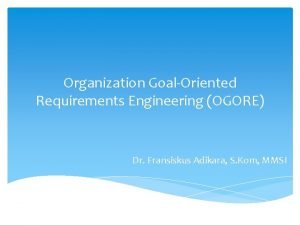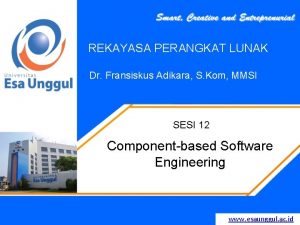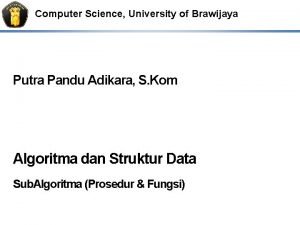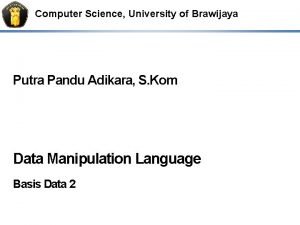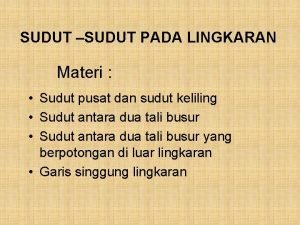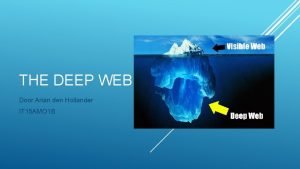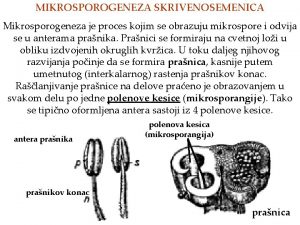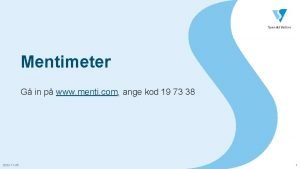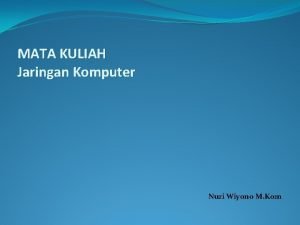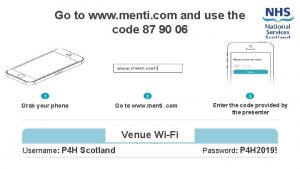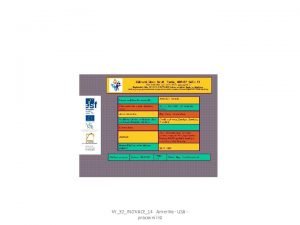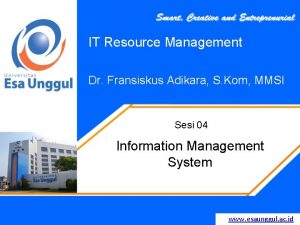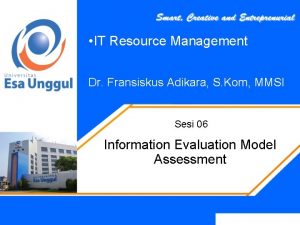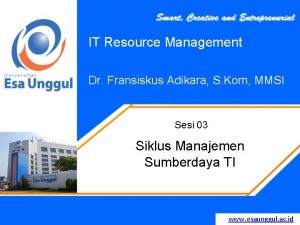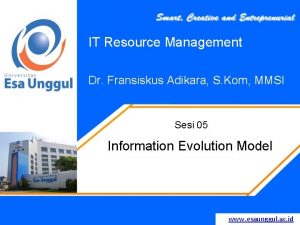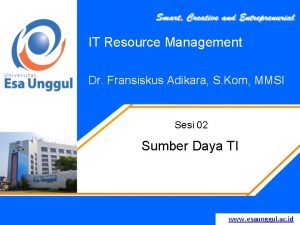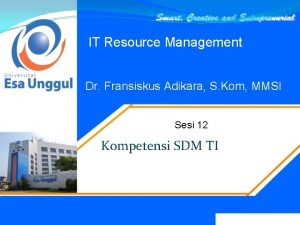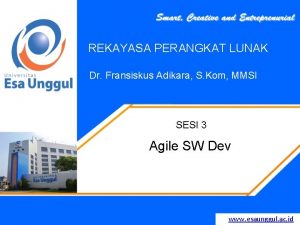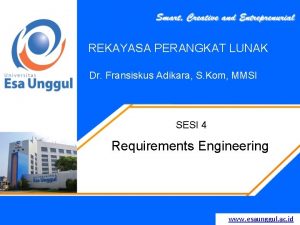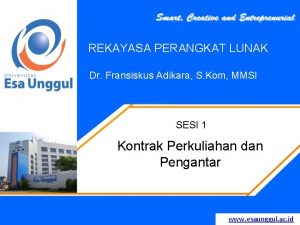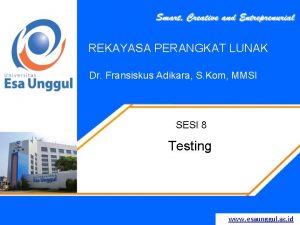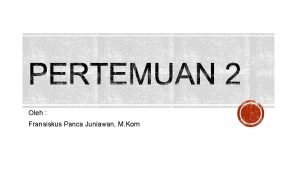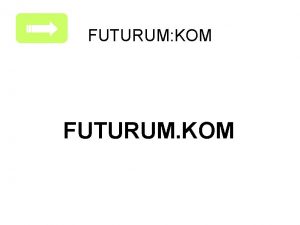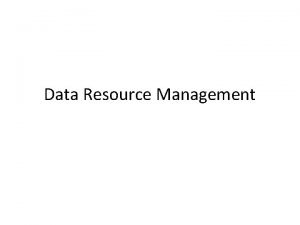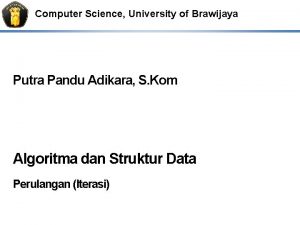IT Resource Management Dr Fransiskus Adikara S Kom






















- Slides: 22

IT Resource Management Dr. Fransiskus Adikara, S. Kom, MMSI Sesi 13 Indikator Kinerja SDM TI

COBIT 5

COBIT 5: Now One Complete Business Framework for Evolution of scope Governance of Enterprise IT IT Governance Val IT 2. 0 Management (2008) Control Risk IT (2009) Audit COBIT 1 1996 COBIT 2 1998 COBIT 3 2000 COBIT 4. 0/4. 1 COBIT 5 2005/7 2012 An business framework from ISACA, at www. isaca. org/cobit © 2012 ISACA® All rights reserved. 3

COBIT 5 Framework COBIT 5: �The main, overarching COBIT 5 product �Contains the executive summary and the full description of all of the COBIT 5 framework components: �The five COBIT 5 principles �The seven COBIT 5 enablers plus �An introduction to the implementation guidance provided by ISACA (COBIT 5 Implementation) �An introduction to the COBIT Assessment Programme (not specific to COBIT 5) and the process capability approach being adopted by ISACA for COBIT 4

COBIT 5 Product Family Source: COBIT® 5, figure 11. © 2012 ISACA® All rights reserved. 5

Five COBIT 5 Principles The five COBIT 5 principles: 1. Meeting Stakeholder Needs 2. Covering the Enterprise End-to-end 3. Applying a Single Integrated Framework 4. Enabling a Holistic Approach 5. Separating Governance From Management 6

1. Meeting Stakeholder Needs Principle 1. Meeting Stakeholder Needs �Enterprises exist to create value for their stakeholders. Source: COBIT® 5, figure 3. © 2012 ISACA® All rights reserved. 7

1. Meeting Stakeholder Needs (cont. ) Principle 1. Meeting Stakeholder Needs: �Enterprises have many stakeholders, and ‘creating value’ means different—and sometimes conflicting—things to each of them. �Governance is about negotiating and deciding amongst different stakeholders’ value interests. �The governance system should consider all stakeholders when making benefit, resource and risk assessment decisions. �For each decision, the following can and should be asked: Who receives the benefits? Who bears the risk? What resources are required? 8

1. Meeting Stakeholder Needs (cont. ) Principle 1. Meeting Stakeholder Needs: �Stakeholder needs have to be transformed into an enterprise’s practical strategy. �The COBIT 5 goals cascade translates stakeholder needs into specific, practical and customised goals within the context of the enterprise, IT-related goals and enabler goals. Source: COBIT® 5, figure 4. © 2012 ISACA® All rights reserved. 9

1. Meeting Stakeholder Needs (cont. ) Principle 1. Meeting Stakeholder Needs: Benefits of the COBIT 5 goals cascade: �It allows the definition of priorities for implementation, improvement and assurance of enterprise governance of IT based on (strategic) objectives of the enterprise and the related risk. �In practice, the goals cascade: �Defines relevant and tangible goals and objectives at various levels of responsibility. �Filters the knowledge base of COBIT 5, based on enterprise goals to extract relevant guidance for inclusion in specific implementation, improvement or assurance projects. �Clearly identifies and communicates how (sometimes very operational) enablers are important to achieve enterprise goals. 10

2. Covering the Enterprise End-to-end Principle 2. Covering the Enterprise End-to-end: �COBIT 5 addresses the governance and management of information and related technology from an enterprisewide, end-to-end perspective. �This means that COBIT 5: �Integrates governance of enterprise IT into enterprise governance, i. e. , the governance system for enterprise IT proposed by COBIT 5 integrates seamlessly in any governance system because COBIT 5 aligns with the latest views on governance. �Covers all functions and processes within the enterprise; COBIT 5 does not focus only on the ‘IT function’, but treats information and related technologies as assets that need to be dealt with just like any other asset by everyone in the enterprise. 11

2. Covering the Enterprise End-to-end (cont. ) Principle 2. Covering the Enterprise End-to-end Key components of a governance system Source: COBIT® 5, figure 8. © 2012 ISACA® All rights reserved. Source: COBIT® 5, figure 9. © 2012 ISACA® All rights reserved. 12

3. Applying a Single Integrated Framework Principle 3. Applying a Single Integrated Framework: �COBIT 5 aligns with the latest relevant other standards and frameworks used by enterprises: �Enterprise: COSO, COSO ERM, ISO/IEC 9000, ISO/IEC 31000 �IT-related: ISO/IEC 38500, ITIL, ISO/IEC 27000 series, TOGAF, PMBOK/PRINCE 2, CMMI �This allows the enterprise to use COBIT 5 as the overarching governance and management framework integrator. �ISACA plans a capability to facilitate COBIT user mapping of practices and activities to third-party references. 13

4. Enabling a Holistic Approach Principle 4. Enabling a Holistic Approach COBIT 5 enablers are: Factors that, individually and collectively, influence whether something will work—in the case of COBIT, governance and management over enterprise IT Driven by the goals cascade, i. e. , higher-level IT-related goals define what the different enablers should achieve Described by the COBIT 5 framework in seven categories 14

4. Enabling a Holistic Approach (cont. ) Principle 4. Enabling a Holistic Approach Source: COBIT® 5, figure 12. © 2012 ISACA® All rights reserved. 15

4. Enabling a Holistic Approach (cont. ) Principle 4. Enabling a Holistic Approach: 1. Processes—Describe an organised set of practices and activities to achieve certain objectives and produce a set of outputs in support of achieving overall IT -related goals 2. Organisational structures—Are the key decision-making entities in an organisation 3. Culture, ethics and behaviour—Of individuals and of the organisation; very often underestimated as a success factor in governance and management activities 4. Principles, policies and frameworks—Are the vehicles to translate the desired behaviour into practical guidance for day-to-day management 5. Information—Is pervasive throughout any organisation, i. e. , deals with all information produced and used by the enterprise. Information is required for keeping the organisation running and well governed, but at the operational level, information is very often the key product of the enterprise itself. 6. Services, infrastructure and applications—Include the infrastructure, technology and applications that provide the enterprise with information technology processing and services 7. People, skills and competencies—Are linked to people and are required for successful completion of all activities and for making correct decisions and taking corrective actions 16

4. Enabling a Holistic Approach (cont). Principle 4. Enabling a Holistic Approach: �Systemic governance and management through interconnected enablers—To achieve the main objectives of the enterprise, it must always consider an interconnected set of enablers, i. e. , each enabler: �Needs the input of other enablers to be fully effective, e. g. , processes need information, organisational structures need skills and behaviour �Delivers output to the benefit of other enablers, e. g. , processes deliver information, skills and behaviour make processes efficient �This is a KEY principle emerging from the ISACA development work around the Business Model for Information Security (BMIS). 17

4. Enabling a Holistic Approach (cont). Principle 4. Enabling a Holistic Approach COBIT 5 Enabler Dimensions: All enablers have a set of common dimensions. This set of common dimensions: Provides a common, simple and structured way to deal with enablers Allows an entity to manage its complex interactions Facilitates successful outcomes of the enablers Source: COBIT® 5, figure 13. © 2012 ISACA® All rights reserved. 18

5. Separating Governance From Management Principle 5. Separating Governance From Management: �The COBIT 5 framework makes a clear distinction between governance and management. �These two disciplines: �Encompass different types of activities �Require different organisational structures �Serve different purposes �Governance—In most enterprises, governance is the responsibility of the board of directors under the leadership of the chairperson. �Management—In most enterprises, management is the responsibility of the executive management under the leadership of the CEO. 19

5. Separating Governance From Management (cont. ) Principle 5. Separating Governance From Management: • Governance ensures that stakeholders needs, conditions and options are evaluated to determine balanced, agreed -on enterprise objectives to be achieved; setting direction through prioritisation and decision making; and monitoring performance and compliance against agreed-on direction and objectives (EDM). • Management plans, builds, runs and monitors activities in alignment with the direction set by the governance body to achieve the enterprise objectives (PBRM). 20

5. Separating Governance From Management (cont. ) Principle 5. Separating Governance From Management: COBIT 5 is not prescriptive, but it advocates that organisations implement governance and management processes such that the key areas are covered, as shown. Source: COBIT® 5, figure 15. © 2012 ISACA® All rights reserved. 21

5. Separating Governance From Management (cont. ) Principle 5. Separating Governance from Management: �The COBIT 5 framework describes seven categories of enablers (Principle 4). Processes are one category. �An enterprise can organise its processes as it sees fit, as long as all necessary governance and management objectives are covered. Smaller enterprises may have fewer processes; larger and more complex enterprises may have many processes, all to cover the same objectives. �COBIT 5 includes a process reference model (PRM), which defines and describes in detail a number of governance and management processes. The details of this specific enabler model can be found in the COBIT 5: Enabling Processes volume. 22
 Ogore
Ogore Fransiskus adikara
Fransiskus adikara Kom heer jezus kom
Kom heer jezus kom Putra pandu adikara
Putra pandu adikara Putra pandu adikara
Putra pandu adikara Resource loading vs resource leveling
Resource loading vs resource leveling Perbedaan resource loading dan resource leveling
Perbedaan resource loading dan resource leveling Materi sudut pusat dan sudut keliling
Materi sudut pusat dan sudut keliling Lief vrouwke ik kom niet om te bidden
Lief vrouwke ik kom niet om te bidden Menticom
Menticom Hoe kom je op het dark web
Hoe kom je op het dark web Enstase
Enstase Mikrogametogeneza
Mikrogametogeneza менти ком
менти ком Www,xxx,kom
Www,xxx,kom Www.menti.com.
Www.menti.com. Emirati kontinent
Emirati kontinent Sinta swastikawara, m.i.kom
Sinta swastikawara, m.i.kom Po kom je pojmenována amerika
Po kom je pojmenována amerika Komponen kunci sig
Komponen kunci sig Kom til mig alle i som er trætte
Kom til mig alle i som er trætte Menti/com
Menti/com Maciej aleksy dawidowski basia
Maciej aleksy dawidowski basia
